
Are you tired of the chaos that ensues every time you open your kitchen storage door? Canned goods tumbling out, expired items hidden in the back, and a general sense of disarray can be overwhelming. You’re not alone!
As someone who’s spent countless hours researching organization methods, I’ve discovered that a well-organized pantry can be a game-changer. It saves time, reduces food waste, and makes meal prep a breeze. Imagine being able to find what you need in seconds, without the stress of a cluttered space.
In this guide, we’ll walk you through practical pantry organization tips to transform your kitchen storage from frustrating to functional. Whether you have a walk-in pantry or a few kitchen cabinets, these techniques will help you create a system that works for your unique needs and cooking habits.
Key Takeaways
- Discover decluttering strategies to simplify your kitchen storage
- Learn clever storage solutions to maximize your kitchen space
- Understand how a well-organized pantry can save you time and reduce food waste
- Create a system that works for your unique cooking habits and needs
- Transform your kitchen storage from frustrating to functional
Why an Organized Pantry Matters
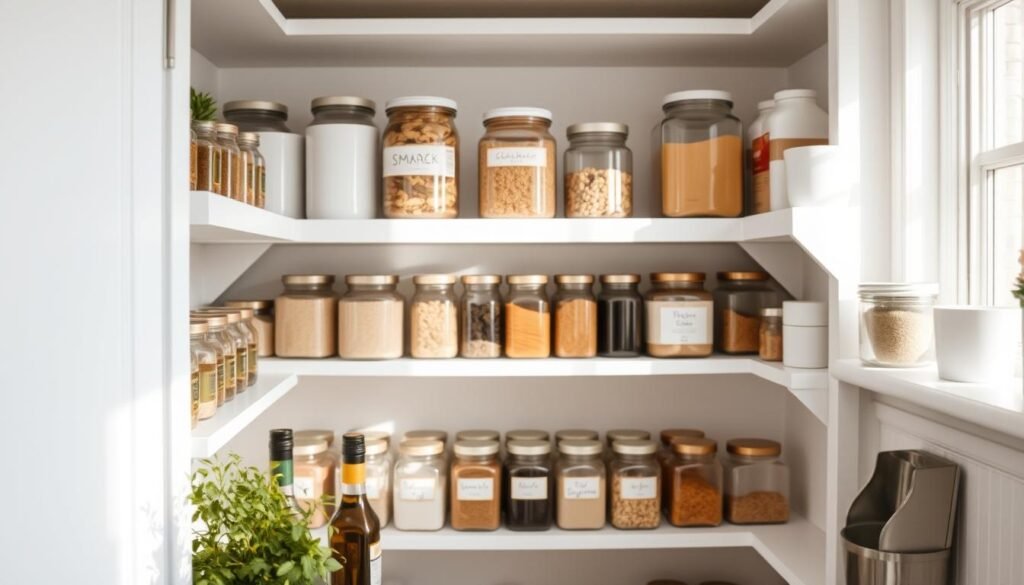
Are you tired of rummaging through your cluttered pantry, searching for that one ingredient you need for dinner? You’re not alone. Many of us struggle with pantry organization, leading to frustration and wasted time. An organized pantry is more than just a tidy space; it’s a foundation for efficient meal planning and cooking.
Common Pantry Challenges
Let’s be honest—your pantry might be the most frustrating space in your entire home right now. Between expired items hiding in the back, duplicate purchases, and the constant struggle to find what you need, it’s no wonder meal prep feels overwhelming! Common challenges include limited space and awkward shelving, which can lead to disorganization after multiple grocery trips.
Benefits of a Well-Organized Pantry
Discover how an organized pantry does more than just look pretty—it fundamentally changes your relationship with cooking and meal planning. The benefits of pantry organization include reduced food waste, streamlined grocery shopping, easier meal preparation, and the surprising mental clarity that comes from knowing exactly what you have. By investing a few hours now in organizing your pantry, you’ll save time and frustration in the future.
Start with a Clean Slate: Decluttering Your Pantry
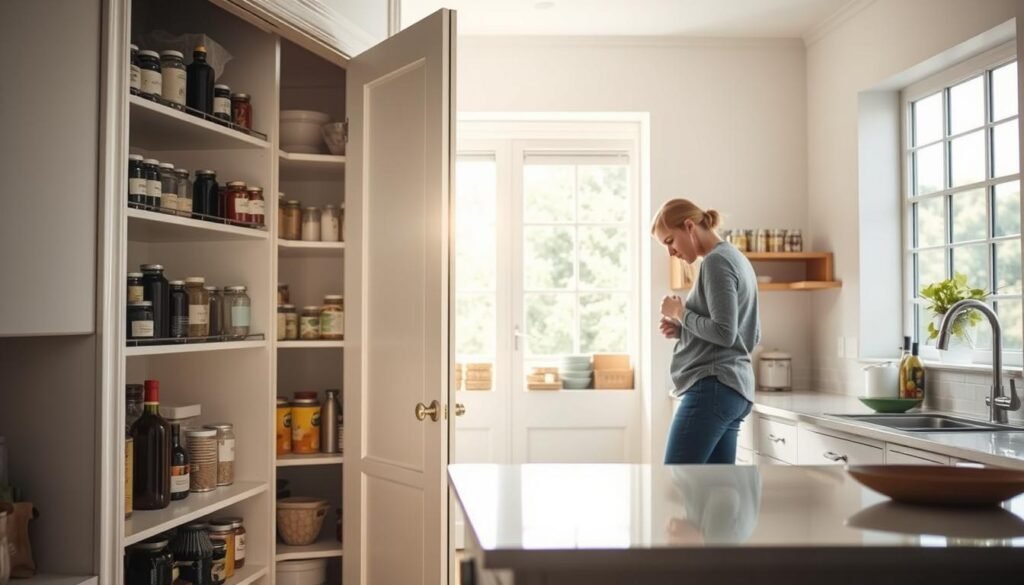
The journey to an organized pantry begins with decluttering. You can’t organize what’s inside your pantry if you don’t know what you have. It’s time to take everything out and give your pantry a fresh start.
Remove Everything and Check Expiration Dates
Start by removing every item from your pantry. As you take things out, check their expiration dates. Get rid of expired or stale items. You’ll likely find things that have been hiding in the back for months or even years. Be ruthless – if it’s expired, it’s time to let it go. Consider donating unopened, unexpired items that you know you won’t use.
Sort and Categorize Items
Once everything is out, sort items into categories. Group similar items together, like grains, canned goods, or baking supplies. This will help you see what you have and make decisions about what to keep, donate, or discard. You might discover that you have duplicates or items you haven’t used in a while. Use this opportunity to create a systematic approach to evaluating each item. Temporarily arrange items in logical groupings on your counter or table to make the next steps easier.
| Category | Action | Notes |
|---|---|---|
| Expired Items | Discard | Check expiration dates carefully |
| Unopened, Unexpired Items | Keep or Donate | Consider your eating habits |
| Duplicates | Keep or Discard | Decide based on usage |
Essential Pantry Organization Tips for Maximum Efficiency
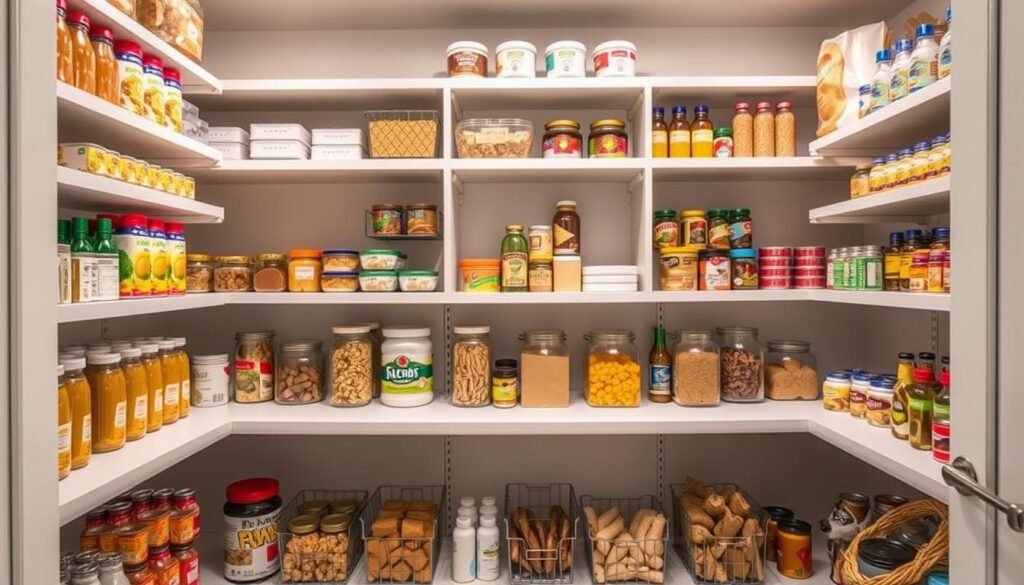
The key to a stress-free cooking experience lies in a pantry that’s organized for efficiency. Now that you’ve decluttered, it’s time to create a pantry organization system that works with your lifestyle. Think about how you use your pantry and create sections for each type of food item.
Create Functional Zones
Organizing your pantry into functional zones can help you keep track of what you have and where everything is. Consider sections for spices, baking supplies, snacks, and canned goods. This approach will help you determine the best storage containers and keep your pantry tidy.
Store Items by Frequency of Use
Storing items based on their frequency of use is a game-changing strategy. Keep everyday essentials at eye level and occasional items higher up or lower down. This method maximizes efficiency and minimizes frustration during meal preparation.
Utilize Every Inch of Space
To truly maximize your pantry’s potential, it’s essential to utilize every inch of space. Look for creative ways to use those awkward corners and narrow gaps that typically go unused. By doing so, you’ll create a more streamlined and functional pantry that makes cooking easier.
By implementing these pantry organization tips, you’ll not only enhance your cooking experience but also encourage healthier eating habits and reduce food waste. A well-organized pantry is more than just a convenience; it’s a step towards a more efficient kitchen.
Storage Solutions That Transform Your Pantry
Discover how the right storage solutions can revolutionize your pantry, making meal prep and cooking a breeze. The right storage products can completely transform your pantry from chaotic to calming—and they don’t have to break the bank!

Clear Containers and Bins
Clear bins or containers are an excellent way to keep your pantry items organized while keeping them visible. Whether you choose plastic, glass, or wire bins, clear storage containers make it easy to see everything you have and avoid buying duplicates of what you already own. Label each bin or container to keep everything organized and easy to find.
Using clear OXO Pop containers for dry goods like flour, sugar, pasta, and cereal not only looks beautiful but also keeps food fresher longer. These containers stack neatly on top of each other, adding some much-needed vertical storage to your pantry.
Baskets and Drawers
Strategic use of bins and baskets can corral similar items together, preventing smaller packages from getting lost and making everything easier to access. You’ll find that baskets are particularly useful for storing items like snacks, spices, or root vegetables.
Drawers can also be a fantastic addition to your pantry, providing a convenient way to store items that you want to keep out of sight. Consider using dividers or inserts to keep contents organized.
Shelf Risers and Expandable Organizers
Shelf risers and expandable organizers can instantly double your usable shelf space, allowing you to see and access items that would otherwise be hidden in the back. These are particularly useful for deep shelves or narrow cabinets where space is limited.
By incorporating these storage solutions into your pantry, you’ll be able to maintain a clutter-free and functional space that makes cooking and meal prep a joy. Choose storage products that are not only functional but also durable enough to withstand daily use in a busy kitchen.
Space-Maximizing Tools and Techniques
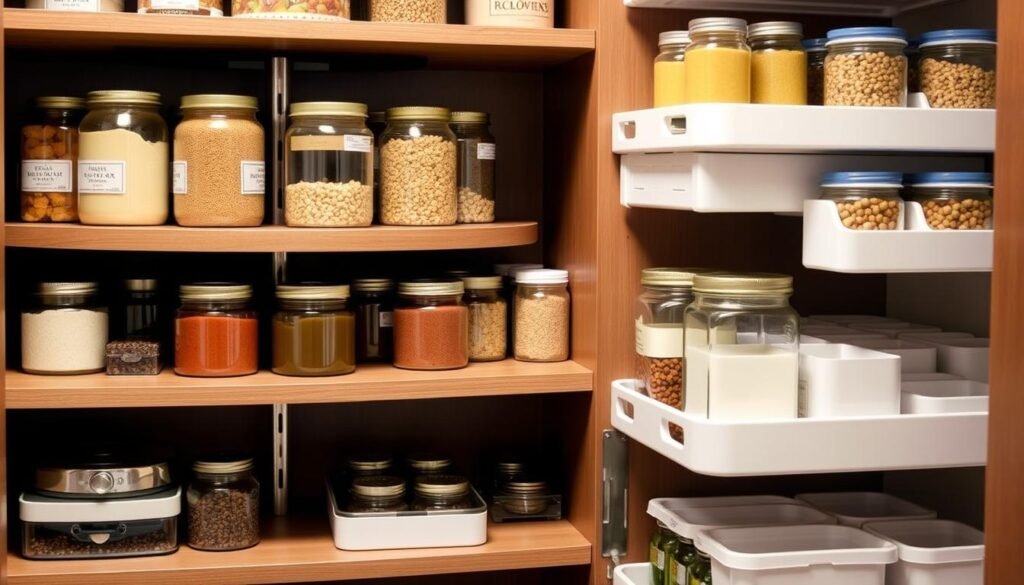
You can revolutionize your pantry’s storage capacity with simple yet effective techniques. Even the most challenging pantry spaces can be transformed with the right tools and strategies—no renovation required! By utilizing space-maximizing tools and techniques, you can make the most of your pantry’s dimensions.
Lazy Susans for Corner Spaces
Lazy susans are a game-changer for corner spaces in your pantry. Corners can be tricky as they often become dead space or items get shoved in and forgotten. Using lazy susans allows you to turn these corners into valuable storage space, making it easy to access items that were previously out of reach.
Door Organizers and Hanging Storage
Your pantry door is prime real estate for storage. By using door organizers and hanging storage solutions, you can maximize the space on your pantry door for slim items like spices, wraps, and bagged snacks. This not only keeps frequently used items within easy reach but also frees up shelf space for other essentials.
Vertical Space Optimization
Maximizing the vertical space in your pantry is crucial for increasing storage capacity. Using shelf stackers for canned goods and other short items can effectively double or triple your shelf space. This technique ensures that you make the most of the often-overlooked vertical space between shelves.
By implementing these space-maximizing tools and techniques, you can create a highly functional and organized pantry that meets your needs. Whether you’re dealing with deep shelves, high ceilings, or awkward nooks, there are strategies available to optimize your pantry space.
Labeling Systems for Foolproof Organization
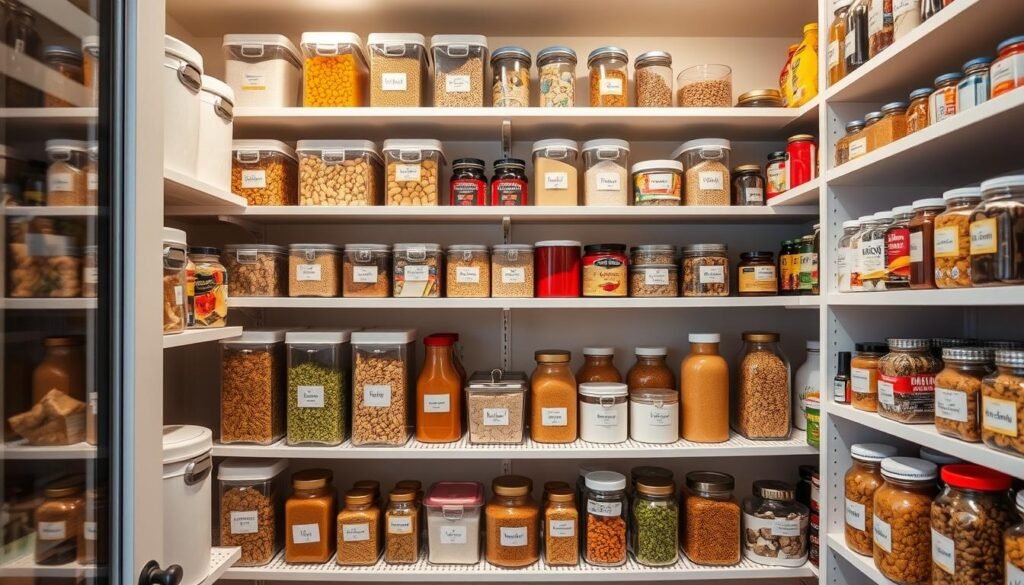
Labeling your pantry items is more than just a neat trick; it’s a system that keeps your kitchen running smoothly. By implementing a labeling system, you’re not just organizing your space; you’re creating a foolproof method that allows everyone in the household to know exactly where things belong.
Label Types and Materials
When it comes to labeling, the type and material of the label are crucial. You can choose from adhesive labels, chalkboard tags, printed labels, or even handwritten options. The key is to select materials that are durable and suitable for your pantry environment. For instance, if you have areas near the sink or stove, consider using moisture-resistant labels to prevent them from deteriorating.
Some popular label materials include paper, plastic, and vinyl. Vinyl labels, for example, are waterproof and can withstand the kitchen environment well. You can also use a label maker or a tool like Cricut to create professional-looking labels that enhance your pantry’s appearance.
What and How to Label Effectively
Effective labeling is not just about slapping a name on a container; it’s about creating a system that works for you and your family. Consider including additional information such as expiration dates, cooking instructions, or dietary information on your labels. This not only helps in maintaining your pantry’s organization but also in meal planning and grocery shopping.
To label effectively, be consistent in your labeling style and ensure that the information is clear and easy to read. You can also use color-coding to differentiate between various categories of items, making it even simpler to navigate your pantry.
By implementing a thoughtful labeling system, you’ll not only maintain your pantry’s organization but also simplify your grocery shopping by easily identifying when supplies are running low. It’s a simple yet effective way to keep your kitchen organized and your family on the same page.
Maintaining Your Organized Pantry
The key to a permanently organized pantry lies in simple, consistent maintenance routines. You’ve invested time and effort into organizing your pantry, and now it’s time to keep it that way. By incorporating a few straightforward habits into your daily and seasonal routines, you can ensure your pantry remains a calm and functional space.
Weekly Quick Tidy-Up Routine
A weekly tidy-up routine is essential for maintaining your pantry’s organization. Set aside just 10 minutes each week to quickly tidy up your pantry. Check that all items are in their designated places, and wipe down any surfaces that need it. This simple routine will prevent your pantry from becoming cluttered again and keep it looking its best.
Seasonal Deep Cleaning Schedule
In addition to your weekly routine, schedule a deeper clean of your pantry on a seasonal basis. This involves removing all items from your pantry, checking expiration dates, and wiping down shelves. It’s also a good opportunity to reorganize your storage systems if needed. By doing this, you’ll keep your pantry fresh and functional throughout the year.
| Maintenance Task | Frequency | Time Required |
|---|---|---|
| Quick Tidy-Up | Weekly | 10 minutes |
| Deep Cleaning | Seasonally | 1-2 hours |
Conclusion: Transform Your Kitchen Experience with an Organized Pantry
As you conclude your pantry organization journey, you’ll discover the transformative power of a well-organized kitchen space. By implementing the tips and techniques outlined in this article, you’ve taken a significant step towards creating a kitchen that works for you, not against you.
Congratulations! You now have all the tools and inspiration needed to transform your pantry from a source of frustration to a kitchen highlight. Your newly organized pantry will not only improve your kitchen’s aesthetics but also make cooking more enjoyable and grocery shopping more strategic.
Remember, an organized pantry is about more than just storage; it’s about creating a home for your food and cooking essentials. By personalizing your pantry organization system, you’ll be more motivated to maintain it, and you’ll be amazed at how much time and money you save in the process.
In conclusion, your organized pantry will positively impact your entire kitchen experience. We encourage you to share your before and after journey with us and enjoy the benefits of your newly transformed kitchen!
FAQ
How often should I declutter my pantry?
It’s a good idea to declutter your pantry every 3-6 months to get rid of expired or unused items and keep your space organized.
What are the best containers for storing food in the pantry?
Clear, airtight containers made of glass or plastic are ideal for storing dry goods like pasta, rice, and snacks. Brands like OXO and Rubbermaid offer a range of options.
How can I maximize the space on my pantry shelves?
Using shelf risers, baskets, and stackable containers can help you make the most of your pantry’s vertical space and keep items off the floor.
What’s the best way to label my pantry items?
Using a label maker with clear, easy-to-read labels can help you identify contents at a glance. Consider using labels made from durable materials like vinyl or plastic.
How can I keep my pantry organized over time?
Establishing a regular cleaning routine, putting away items after use, and periodically reviewing your pantry’s contents can help maintain your space.
Can I use baskets to store canned goods?
Yes, baskets can be a great way to store canned goods, keeping them visible and accessible. Look for baskets with sturdy handles and a stable base.
How can I make the most of my pantry’s corner spaces?
Using a lazy Susan or a carousel can help you access items in corner spaces easily, making the most of this often-wasted area.
